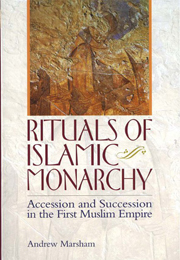Book contents
- Frontmatter
- Contents
- List of maps and figures
- Acknowledgements
- Map 1
- Map 2
- Map 3
- INTRODUCTION
- PART I LATE ANTIQUE ARABIA AND EARLY ISLAM (c. 550–c. 660)
- PART II THE UMAYYAD CALIPHATE (c. 660–750)
- PART III THE EARLY ABBASID CALIPHATE (c. 750–809)
- PART IV THE MIDDLE ABBASID CALIPHATE (809–865)
- INTRODUCTION
- 13 FROM THE CIVIL WAR TO SAMARRA (809–847)
- 14 CALIPHATE OF AL-MUTAWAKKIL (847–861)
- 15 THE OUTBREAK OF THE SECOND NINTH-CENTURY CIVIL WAR (861–865)
- 16 ABBASID DOCUMENTS FOR CALIPHAL ACCESSION
- CONCLUSION
- Genealogical table of Quraysh
- Genealogical table of the Abbasid caliphs
- Bibliography
- Index
INTRODUCTION
from PART IV - THE MIDDLE ABBASID CALIPHATE (809–865)
Published online by Cambridge University Press: 05 September 2013
- Frontmatter
- Contents
- List of maps and figures
- Acknowledgements
- Map 1
- Map 2
- Map 3
- INTRODUCTION
- PART I LATE ANTIQUE ARABIA AND EARLY ISLAM (c. 550–c. 660)
- PART II THE UMAYYAD CALIPHATE (c. 660–750)
- PART III THE EARLY ABBASID CALIPHATE (c. 750–809)
- PART IV THE MIDDLE ABBASID CALIPHATE (809–865)
- INTRODUCTION
- 13 FROM THE CIVIL WAR TO SAMARRA (809–847)
- 14 CALIPHATE OF AL-MUTAWAKKIL (847–861)
- 15 THE OUTBREAK OF THE SECOND NINTH-CENTURY CIVIL WAR (861–865)
- 16 ABBASID DOCUMENTS FOR CALIPHAL ACCESSION
- CONCLUSION
- Genealogical table of Quraysh
- Genealogical table of the Abbasid caliphs
- Bibliography
- Index
Summary
The first two-thirds of the ninth century were framed by two destructive civil wars, in 811–19 and 865–70. The first was a war of succession fought between Khurasan and Iraq. Khurasan backed Hārūn al-Rashīd's second heir, al-Maɔmūn, against the new caliph, al-Amīn (r. 809–13), in Iraq. After Iraq's defeat, the Iraqi Abbasids and the Abnāɔ. (that is, the descendants of the revolutionary army) lost their leading place in the government of the empire; they were replaced by local dynasts in the provinces – most importantly the Ṭāhirids of Khurasan – and, especially after the accession of al-Muctaṣim (r. 833–42), by a new elite cavalry guard composed predominantly of slaves of Central Asian origin. These ‘Turks’ (Ar. atrāk, sing. turk) dominated at the centre of the caliphate and in the western provinces of Egypt and Syria. The new regime had some significant military successes in the 820s and 830s, both against the Byzantines on the Anatolian frontier and, on the internal frontiers of Azerbaijan and Ṭabaristān, against rebels. However, the extent of the dislocation caused by the civil war, and the marginalisation of the old Iraqi elites by new Khurasani, Transoxianan and Turkish ones, appear to be reflected in the decision to move the caliphal capital to the new foundation of Samarra, 100 kilometres up the Tigris from Baghdad, in 835–6.
The second ninth-century civil war (865–70) was a consequence of factional conflict within the Samarran elite that spilled over into a war between the predominantly Arab and Iranian elites in Baghdad and the Turkish commanders at Samarra.
- Type
- Chapter
- Information
- Rituals of Islamic MonarchyAccession and Succession in the First Muslim Empire, pp. 253 - 258Publisher: Edinburgh University PressPrint publication year: 2009



